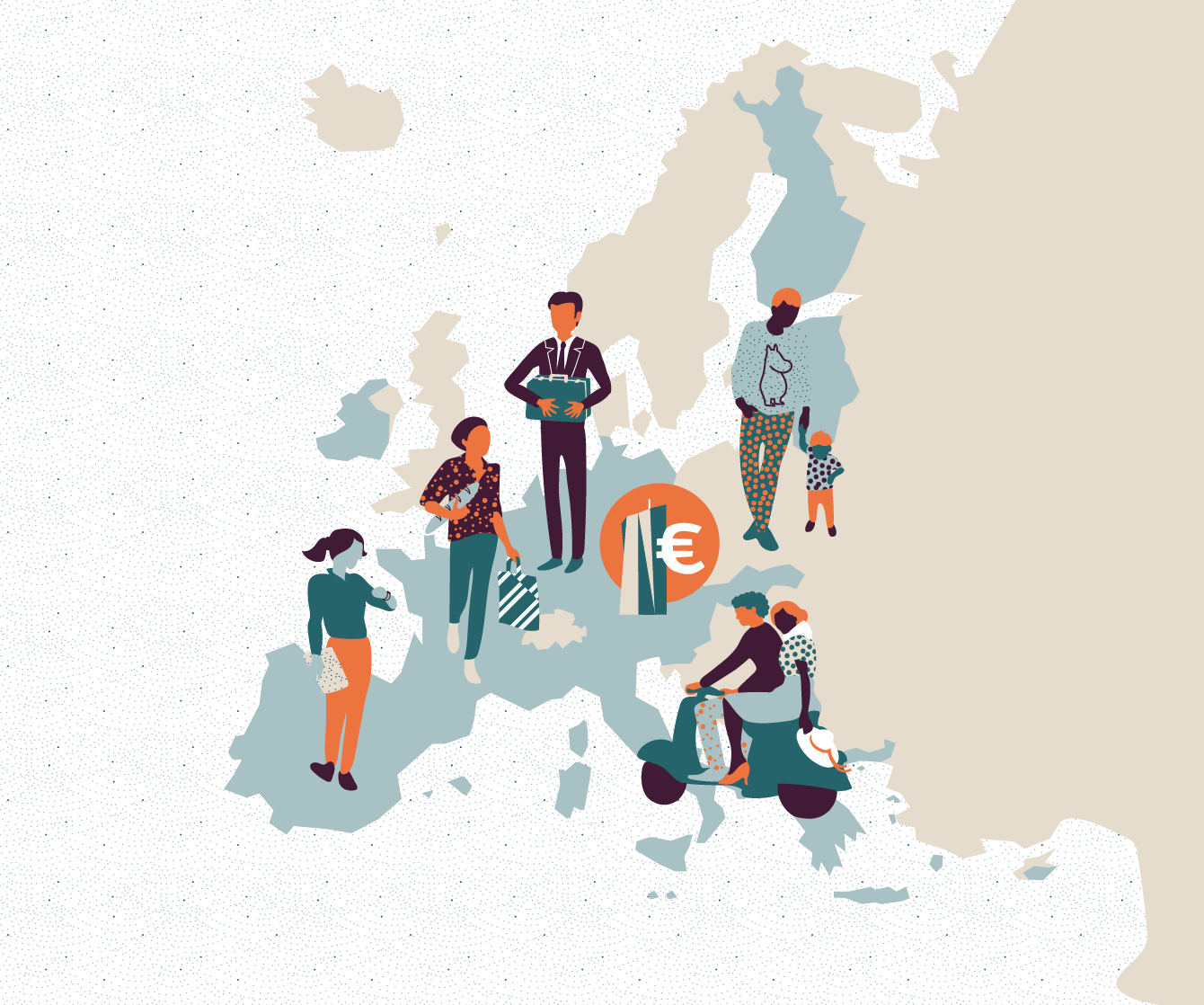Knowledge Base
Europe
The euro was planned during a period in which economic policy making was driven by a deep belief in market liberalism and the near impossibility of systemic financial crises. This belief has been brought into question since the euro crisis, which showed that panics do happen. New thinking needs to focus on developing mechanisms to protect eurozone countries from such panics and to foster economic convergence between members.

The Challenge
The ECB’s continuing program of bond purchases and its emergency lending to struggling banks show the underlying instability of the eurozone.
A decade after the outbreak of the euro-crisis the public deficits of all member-states are now back below the 3 per cent of GDP laid down in the Maastricht Treaty. Current account imbalances within the currency union have also been sharply reduced and unemployment levels are close to pre-crisis levels, and below those levels in some member-states, such as Germany and the Netherlands.
Nevertheless, the eurozone still faces serious risks. Public debt remains at close to 100% of GDP in France and Spain and over 135% in Italy. Current account deficits may have been reduced, but to a large extent this reflects weak domestic demand (and hence imports) rather than sustainable economic rebalancing. Despite years of historically low official interest rates and a large program of government bond purchases by the European Central Bank (ECB), the eurozone’s eurozone recovery since the crisis has been weak, and inflation remains a long way below the central bank’s target of ‘below, but close to 2%’.
Moreover, economic growth has weakened sharply over the last year, raising the possibility that some eurozone economies could fall into recession before they have properly recovered from the previous one. In response, the ECB announced in September 2019 that it would restart its government bond purchases and continue lending to cash-strapped banks under its ‘targeted longer-term refinancing operations’ (TLTROs).
The biggest challenge facing the eurozone is that the members disagree over what reforms are necessary. On the one hand, many people in countries such as Germany and Holland fear being pushed into a transfer union that they did not vote for and are bearing the costs of excessively loose monetary policies needed to keep badly run southern eurozone economies afloat. For their part, many in countries such as Italy maintain that they are paying the price for the eurozone’s failure to accept that a stable currency union requires a degree of political integration. They argue that market harmonization and integration alone is insufficient to guarantee convergence and avoid self-reinforcing market panics that have done such damage to their economies.
What went wrong
A deep belief in self-regulating markets and market-driven integration failed to lead to convergence. It instead led to divergence and major imbalances.
The challenges facing the eurozone have their origins in the Maastricht Treaty, which was prepared at the high time of market liberalism. Market liberalization and integration, together with competition between participating economies and rules (for example, governing the size of budget deficits) would make the euro a success. If governments pushed through supply-side reforms and abided by the rules their economies would grow faster and converge with one another. Political integration, without which it is impossible for the ECB to fully play the role of lender of last resort or for funds to be transferred between member-states, was deemed unnecessary. The eurozone remains a market-driven project to this day.

The architects believed that market-driven integration would come about through several mechanisms. First, by increasing trade among member-states and facilitating greater price transparency and competition, the euro would make it harder for governments to shield sectors or particular companies from competition. The integration of product markets and the development of cross-border supply chains would lead to a convergence in productivity levels, fostering economic convergence in living standards.
Second, because countries would no longer be free to devalue their currencies in the face of an economic shock or loss of competitiveness brought on by excessive wage growth, governments would be forced to encourage labour mobility as well as labour market and wage flexibility in order to facilitate adjustment, thus converging on common – liberal – labour market policies. The more flexible a country was, the less likely it would be to lose competitiveness.
Third, a single currency would hasten the development of an integrated banking and financial market, reducing the cost of capital and ensuring a more efficient allocation of resources. This would facilitate cross-border investment and help member-states with low levels of capital intensity to catch up with more developed ones. While some pointed to the potential risks of more integrated banking and financial markets, such as “hot” capital flows into already booming regions, current account imbalances within the currency union were generally considered no more of a threat than those among US states or within EU member-states, say between Bavaria and Berlin, and would not persist in any case as competitiveness levels converged.
The Stability and Growth Pact (SGP), meanwhile, stipulated that public sector deficits should be in balance over the economic cycle, that the deficit must not exceed 3% of GDP (other than in exceptional circumstances), and that outstanding stocks of national debt should be kept under 60% of GDP. These rules, it was believed, would prevent member-states from exploiting the lower interest rates to overspend, which would lead to excessive demand growth, higher inflation and lost competitiveness. There was little acknowledgement that flexible macroeconomic rules might be necessary in the absence of currency flexibility. That is, absent exchange rate flexibility and with interest rates set for the eurozone as a whole, governments could need more, not less, fiscal flexibility.
Because the architects of the eurozone believed that current account imbalances within the currency union would not matter or that market integration would prevent them from emerging in the first place, they were slow to appreciate that there could be a need for ‘symmetric adjustment’ between countries. That is, following a crisis it might be necessary for countries with large trade surpluses to stimulate their domestic economies in order to offset the weakening of domestic demand in countries attempting to bring down trade deficits. Similarly, the risk of central banks losing their lender-of-last resort function was poorly understood.
In common with their counterparts elsewhere, European policy-makers did not foresee the risk of self-fulfilling panics in which investors lost confidence in the solvency of banks or sovereigns; it was assumed that market-driven integration would prevent a systematic financial crisis from arising.
The eurozone crisis, which began in 2010, was triggered when investors started to doubt the sustainability of some countries’ membership in the common currency. These fears led to the withdrawal of funds from struggling countries, including from banks and sovereign bonds, which in turn did make the membership of those countries unsustainable. A breakup of the eurozone was prevented when ECB President Mario Draghi announced the central bank’s Outright Monetary Transactions (OMT), a promise to buy as many government bonds as necessary to ensure the solvency of member-states. The announcement did enough to reassure investors, but it has never been tested and is unclear how it would work in the case of a crisis in Italy, which is the third biggest sovereign debtor in the world.
For example, the ECB can only launch OMT once Italy applies for a bail-out from the European Stability Mechanism (ESM), a European Union agency that provides financial assistance in the form of loans to eurozone countries. To receive a bail-out Italy would have to sign-up to terms governing public spending, which could prove politically impossible for the Italian government. It is also unclear how all this would play out in the heat of a crisis, when authorities need to act quickly. Or indeed whether the around €400bn the ESM now has its disposal would be enough to cope with a sovereign and banking sector crisis in Italy, or how the further large-scale increase in the stock of Italian public debt would be sustainable.
New Economy in Progress
New research focuses on the policies – macroeconomic, institutional and regulatory – needed to ensure convergence, prevent shocks and improve crisis management.
There is broad consensus that market integration within Europe is essential; it is part of the glue that holds the region together by generating powerful bonds of self-interest. But in debates about the future of the eurozone, most accept that continued divergence in economic fortunes between member-states is politically corrosive for the European project. There is, however, little agreement on the instruments that could bring about less divergence, let alone convergence.

Some economists believe a crucial component of a new paradigm should include reform of the ECB’s mandate to make its lender of last resort function explicit; at present, is an implicit political deal subject to political decisions at the eurozone level (such as on debt sustainability). But this would require the existence of a common European safe asset. At present the de facto eurozone safe asset is the German 10-year bond, and Germany benefits or gets a ‘rent’ from this in the form of very low bond yields and hence borrowing costs. Were the eurozone’s member-states to agree to jointly issue Eurobonds – in the process making eurozone countries responsible for each other’s debt states – the currency union would have a common safe asset, enabling the ECB to act as a fully-fledged lender of last resort. This, many economists believe, could facilitate long-term convergence; at present the governments of weaker countries (and the firms and households based in then) pay higher real interest rates than their better off counterparts.
But the issuance of Eurobonds would require a degree of political integration well beyond what is currently possible within the eurozone; a eurozone budget backed by the issuance of common eurozone debt would comprise a transfer mechanism. A possible quid pro quo for Germany agreeing to the common issuance of debt could be other eurozone member-states to agree to adopt restrictive fiscal regime similar to that in place in Germany itself. But such is the current political toxicity of any transfer mechanism, even attempts to reach agreement on a common system of unemployment insurance have come to nothing. In the face of this political stalemate, the eurozone has limited itself to the establishment of a so-called Budgetary Instrument for Convergence, a fund of €17bn to be disbursed over a 7-year period. Many experts though argue that this is too little to provide a counter-cyclical stimulus across the eurozone in a downturn and will be financed through the existing EU budget rather than involving additional funds.
The completion of the EU’s banking union is seen by many as another necessary element of a new paradigm.
Notwithstanding the establishment of the ESM, the ties between banks and their home sovereign remain strong within the eurozone, which means that in times of stress, banks may still be subject to deposit flight. But there is disagreement over what a comprehensive banking union would look like. For some, it would require a common safe asset as a large common fiscal backstop to the eurozone’s banking system; others think it would be sufficient to increase the funds under disposal at the ESM and agree a system of common deposit insurance. The German finance minister, Olaf Scholz, argued in November 2019 that Germany should end its opposition to common deposit insurance, but it is unclear whether other member-states will accept Germany’s conditions, such as that they take further steps to strengthen their banks and place tighter limits on the amount of domestic government bonds these banks can hold on their balance sheets. There is some support for a capital markets union, which could help mutualize risk by fostering cross-country investment (and diffusing the costs of a crisis in a particular member-state), but this too requires political integration, for example in the areas of insolvency regimes and business taxation, which is currently not achievable.
For a growing number of economists, a further element in a new paradigm could be a rethinking of national ‘competitiveness’. They argue eurozone countries should place more emphasis on boosting domestic demand and less on maximizing export ‘competitiveness’. Current account balances within the eurozone have not been competed away as the market liberals thought inevitable. And in the absence of risk-sharing mechanisms it arguably puts pressure on all eurozone to emulate those countries’ strategies (in a drive to become creditors and hence reduce the risk of market-driven panics). The simultaneous drive by all members of the eurozone to run trade surpluses has resulted in large eurozone surplus with the rest of the world, leaving the bloc vulnerable to a worsening global economic outlook.







